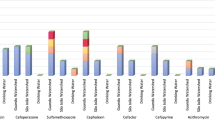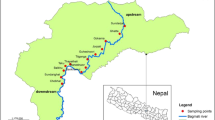Abstract
Antimicrobial resistance (AMR) is currently discussed as an important issue worldwide, and the presence of antimicrobial residues (ARs) and antimicrobial resistance genes (ARGs) in the environment, especially in the water sources, is a challenge for public health. This study was conducted to evaluate the occurrence and diversity of AR and ARG in water sources from an urban center, in Southern Brazil. A total of thirty-two water samples from drinking water treatment plants (24) and sewage systems (8) were collected during two annual samplings, winter and summer. The PCR was performed by 18 ARGs, and the detection of 47 ARs was performed by LC–MS/MS. All sewage samples presented carbapenemases, ESBL, and mcr-1 genes as well as quinolones and sulfamethoxazole residues. In drinking water, we just detected blaTEM and tetB genes and doxycycline residues in samples before treatment. This study provides data about AR and ARG in drinking water and sewage systems showing that these sources are important reservoirs of both. The limited effectiveness of wastewater treatment processes to remove mainly AR demonstrates the need to implement better protocols of disinfection, in order to limit the spread of AMR in the environment.

Similar content being viewed by others
References
Rizzo L, Manaia C, Merlin C et al (2013) Urban wastewater treatment plants as hotspots for antibiotic resistant bacteria and genes spread into the environment: a review. Sci Total Environ 447:345–360. https://doi.org/10.1016/J.SCITOTENV.2013.01.032
Fair RJ, Tor Y (2014) Antibiotics and bacterial resistance in the 21st century. Perspect Medicin Chem 6:25–64. https://doi.org/10.4137/PMC.S14459
Sobsey MD et al (2014) Briefing note antimicrobial resistance: an emerging water, sanitation and hygiene issue. World Health Organization WHO. https://apps.who.int/iris/rest/bitstreams/910174/retrieve. Accessed 25 Apr 2022
Centers for Disease Control and Prevention (2019) Antibiot resist threat United States CDC. Atlanta, GA. https://doi.org/10.15620/cdc:82532
Cassini A, Plachouras D, Monnet DL (2019) Attributable deaths caused by infections with antibiotic-resistant bacteria in France – authors’ reply. Lancet Infect Dis 19:129–130. https://doi.org/10.1016/S1473-3099(19)30004-0
Cabello FC (2006) Heavy use of prophylactic antibiotics in aquaculture: a growing problem for human and animal health and for the environment. Environ Microbiol 8:1137–1144. https://doi.org/10.1111/J.1462-2920.2006.01054.X
Van Boeckel TP, Gandra S, Ashok A et al (2014) Global antibiotic consumption 2000 to 2010: an analysis of national pharmaceutical sales data. Lancet Infect Dis 14:742–750. https://doi.org/10.1016/S1473-3099(14)70780-7
Ferreira AE, Marchetti DP, De Oliveira LM, et al (2011) Presence of OXA-23-producing isolates of Acinetobacter baumannii in wastewater from hospitals in Southern Brazil. https://home.liebertpub.com/mdr 17:221–227. https://doi.org/10.1089/MDR.2010.0013
Fuentefria DB, Ferreira AE, Gräf T, Corção G (2009) Spread of metallo-β-lactamases: screening reveals the presence of a BLA SPM-1 gene in hospital sewage in southern Brazil. Brazilian J Microbiol 40:82–85. https://doi.org/10.1590/S1517-83822009000100013
Bartley PS, Domitrovic TN, Moretto VT et al (2019) Antibiotic resistance in enterobacteriaceae from surface waters in urban Brazil highlights the risks of poor sanitation. Am J Trop Med Hyg 100:1369–1377. https://doi.org/10.4269/AJTMH.18-0726
Neves e Castro PB, da Silva Rodrigues DA, Roeser HMP et al (2020) Antibiotic consumption in developing countries defies global commitments: an overview on Brazilian growth in consumption. Environ Sci Pollut Res 27(17):21013–21020. https://doi.org/10.1007/S11356-020-08574-X
Kümmerer K (2009) Antibiotics in the aquatic environment – a review – Part I. Chemosphere 75:417–434. https://doi.org/10.1016/J.CHEMOSPHERE.2008.11.086
Voigt AM, Zacharias N, Timm C et al (2020) Association between antibiotic residues, antibiotic resistant bacteria and antibiotic resistance genes in anthropogenic wastewater – an evaluation of clinical influences. Chemosphere 241:125032. https://doi.org/10.1016/j.chemosphere.2019.125032
Fajardo A, Martínez JL (2008) Antibiotics as signals that trigger specific bacterial responses. Curr Opin Microbiol 11:161–167. https://doi.org/10.1016/J.MIB.2008.02.006
Berglund B (2015) Environmental dissemination of antibiotic resistance genes and correlation to anthropogenic contamination with antibiotics. 5:28564. https://doi.org/10.3402/IEE.V5.28564
Kraemer SA, Ramachandran A, Perron GG (2019) Antibiotic pollution in the environment: from microbial ecology to public policy. Microorg 7:180 7-180. https://doi.org/10.3390/MICROORGANISMS7060180
Hu Y, Gao GF (2017) Zhu B (2017) The antibiotic resistome: gene flow in environments, animals and human beings. Front Med 112(11):161–168. https://doi.org/10.1007/S11684-017-0531-X
Hassoun-Kheir N, Stabholz Y, Kreft JU et al (2020) Comparison of antibiotic-resistant bacteria and antibiotic resistance genes abundance in hospital and community wastewater: a systematic review. Sci Total Environ 743:140804. https://doi.org/10.1016/J.SCITOTENV.2020.140804
Zhuang M, Achmon Y, Cao Y et al (2021) Distribution of antibiotic resistance genes in the environment. Environ Pollut 285:117402. https://doi.org/10.1016/J.ENVPOL.2021.117402
Liu X, Zhang G, Liu Y et al (2019) Occurrence and fate of antibiotics and antibiotic resistance genes in typical urban water of Beijing, China. Environ Pollut 246:163–173. https://doi.org/10.1016/J.ENVPOL.2018.12.005
Cacace D, Fatta-Kassinos D, Manaia CM et al (2019) Antibiotic resistance genes in treated wastewater and in the receiving water bodies: a pan-European survey of urban settings. Water Res 162:320–330. https://doi.org/10.1016/j.watres.2019.06.039
Lübbert C, Baars C, Dayakar A et al (2017) (2017) Environmental pollution with antimicrobial agents from bulk drug manufacturing industries in Hyderabad, South India, is associated with dissemination of extended-spectrum beta-lactamase and carbapenemase-producing pathogens. Infect 454(45):479–491. https://doi.org/10.1007/S15010-017-1007-2
Mao D, Yu S, Rysz M et al (2015) Prevalence and proliferation of antibiotic resistance genes in two municipal wastewater treatment plants. Water Res 85:458–466. https://doi.org/10.1016/J.WATRES.2015.09.010
Debroas D (2019) Siguret C (2019) Viruses as key reservoirs of antibiotic resistance genes in the environment. ISME J 1311(13):2856–2867. https://doi.org/10.1038/s41396-019-0478-9
Czekalski N, Gascón Díez E (2014) Bürgmann H (2014) Wastewater as a point source of antibiotic-resistance genes in the sediment of a freshwater lake. ISME J 87(8):1381–1390. https://doi.org/10.1038/ismej.2014.8
Sanchez DG, de Melo FM, Savazzi EA (2018) Stehling EG (2018) Detection of different β-lactamases encoding genes, including blaNDM, and plasmid-mediated quinolone resistance genes in different water sources from Brazil. Environ Monit Assess 1907(190):1–8. https://doi.org/10.1007/S10661-018-6801-5
BRASIL. Ministério da Saúde. Secretaria de Vigilância em Saúde. (2006) Manual de procedimentos em vigilância em saúde ambiental relacionada à qualidade da água para consumo humano. https://bvsms.saude.gov.br/bvs/publicacoes/manual_procedimentos_agua_consumo_humano.pdf. Accessed 25 Apr 2022
(2013) Plano Municipal de Saneamento Básico. In: Prefeitura Munic. Porto Alegre, Dep. Munic. Água e Esgoto. http://www2.portoalegre.rs.gov.br/dmae/default.php?p_noticia=183052&AUDIENCIA+PUBLICA+PARA+O+PLANO+MUNICIPAL+DE+SANEAMENTO. Accessed 25 Apr 2022
Pena A, Paulo M, Silva LJG et al (2010) (2010) Tetracycline antibiotics in hospital and municipal wastewaters: a pilot study in Portugal. Anal Bioanal Chem 3968(396):2929–2936. https://doi.org/10.1007/S00216-010-3581-3
Zainab SM, Junaid M, Xu N, Malik RN (2020) Antibiotics and antibiotic resistant genes (ARGs) in groundwater: A global review on dissemination, sources, interactions, environmental and human health risks. Water Res 187:116455. https://doi.org/10.1016/J.WATRES.2020.116455
Javid A, Mesdaghinia A, Nasseri S et al (2016) Assessment of tetracycline contamination in surface and groundwater resources proximal to animal farming houses in Tehran. Iran J Environ Heal Sci Eng 14:1–5. https://doi.org/10.1186/S40201-016-0245-Z/TABLES/2
Osińska A, Korzeniewska E, Harnisz M, Niestȩpski S (2019) Quantitative occurrence of antibiotic resistance genes among bacterial populations from wastewater treatment plants using activated sludge. ApplSci 9:387. https://doi.org/10.3390/APP9030387
Wang M, Shen W, Yan L et al (2017) Stepwise impact of urban wastewater treatment on the bacterial community structure, antibiotic contents, and prevalence of antimicrobial resistance. Environ Pollut 231:1578–1585. https://doi.org/10.1016/J.ENVPOL.2017.09.055
BRASIL - ANVISA - Agência Nacional de Vigilância Sanitária - Boletim Segurança do Paciente e Qualidade em Serviços de Saúde no 21. Avaliação dos indicadores nacionais das infecções relacionadas à Assistência à Saúde (IRAS) e Resistência Microbiana no ano de 2018. https://app.powerbi.com/view?r=eyJrIjoiODkzMzNiYmQtYWRkYi00NzRmLWI1ZGQtYjI5NGEzNjk1YTE0IiwidCI6ImI2N2FmMjNmLWMzZjMtNGQzNS04MGM3LWI3MDg1ZjVlZGQ4MSJ9. Accessed 25 Apr 2022
Xu J, Xu Y, Wang H et al (2015) Occurrence of antibiotics and antibiotic resistance genes in a sewage treatment plant and its effluent-receiving river. Chemosphere 119:1379–1385. https://doi.org/10.1016/J.CHEMOSPHERE.2014.02.040
Xu W, Zhang G, Zou S, Li X-D, Liu Y (2007) Occurrence and seasonal changes of antibiotics in the Victoria Harbour and the Pearl River, South China. Huan Jing Ke Xue 27:2458–2462
Jiang L, Hu X, Yin D et al (2011) Occurrence, distribution and seasonal variation of antibiotics in the Huangpu River, Shanghai, China. Chemosphere 82:822–828. https://doi.org/10.1016/J.CHEMOSPHERE.2010.11.028
Diwan V, Stålsby Lundborg C, Tamhankar AJ (2013) Seasonal and temporal variation in release of antibiotics in hospital wastewater: estimation using continuous and grab sampling. PLoS ONE 8:e68715. https://doi.org/10.1371/JOURNAL.PONE.0068715
Gu Q, Sun M, Lin T et al (2022) Characteristics of antibiotic resistance genes and antibiotic-resistant bacteria in full-scale drinking water treatment system using metagenomics and culturing. Front Microbiol 12:798442. https://doi.org/10.3389/FMICB.2021.798442
Funding
The research leading to these results received funding from Coordenação de Aperfeiçoamento de Pessoal de Nível Superior, Grant/Award Number: Finance Code 001; Fundação de Amparo à Pesquisa do Estado do Rio Grande do Sul, Grant/Award Number: FAPERGS/MS/CNPq/SESRS N° 03/2017—PPSUS.
Author information
Authors and Affiliations
Corresponding author
Ethics declarations
Conflict of interest
The authors declare no competing interests.
Additional information
Publisher's note
Springer Nature remains neutral with regard to jurisdictional claims in published maps and institutional affiliations.
Responsible Editor: Ernani Pinto
Supplementary Information
Below is the link to the electronic supplementary material.
Rights and permissions
About this article
Cite this article
Ramalho, R., Mezzomo, L.C., Machado, W. et al. The occurrence of antimicrobial residues and antimicrobial resistance genes in urban drinking water and sewage in Southern Brazil. Braz J Microbiol 53, 1483–1489 (2022). https://doi.org/10.1007/s42770-022-00786-2
Received:
Accepted:
Published:
Issue Date:
DOI: https://doi.org/10.1007/s42770-022-00786-2




